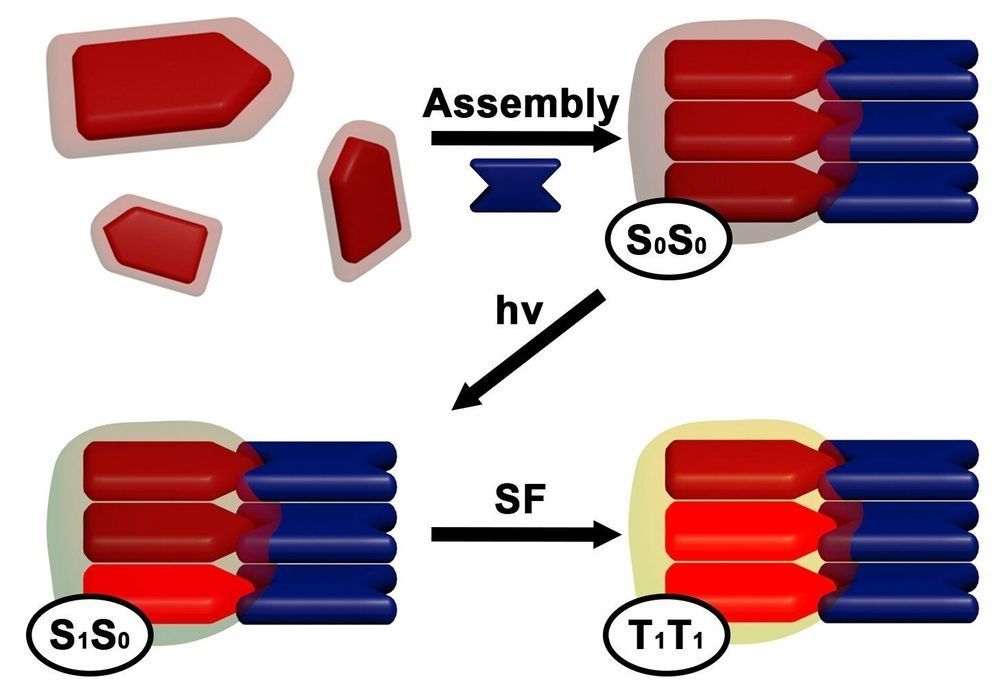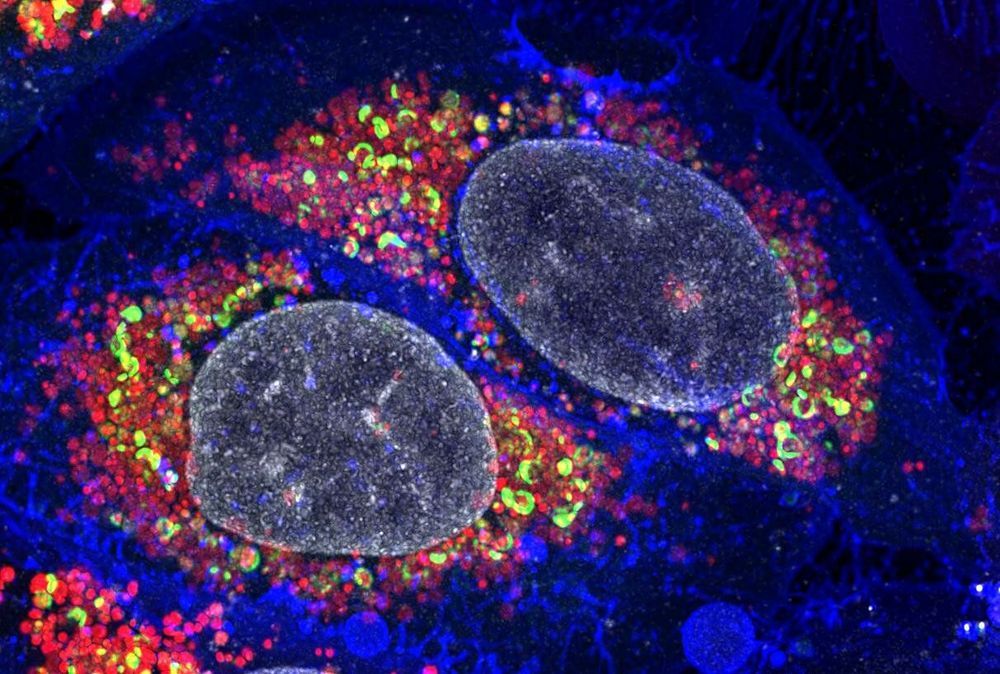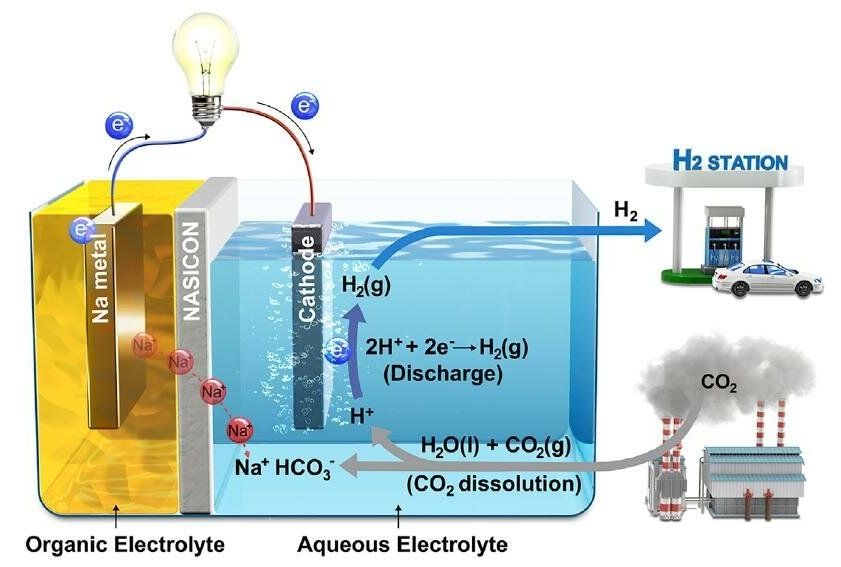Archive for the ‘sustainability’ category: Page 523
Jan 26, 2019
Scientists Create Liquid Fuel That Can Store The Sun’s Energy For Up to 18 Years
Posted by Victoria Generao in categories: solar power, sustainability
No matter how abundant or renewable, solar power has a thorn in its side. There is still no cheap and efficient long-term storage for the energy that it generates.
The solar industry has been snagged on this branch for a while, but in the past year alone, a series of four papers has ushered in an intriguing new solution.
Scientists in Sweden have developed a specialised fluid, called a solar thermal fuel, that can store energy from the sun for well over a decade.
Jan 25, 2019
Self-assembling nanomaterial offers pathway to more efficient, affordable harnessing of solar power
Posted by Genevieve Klien in categories: nanotechnology, solar power, sustainability
Solar rays are a plentiful, clean source of energy that is becoming increasingly important as the world works to shift away from power sources that contribute to global warming. But current methods of harvesting solar charges are expensive and inefficient—with a theoretical efficiency limit of 33 percent. New nanomaterials developed by researchers at the Advanced Science Research Center (ASRC) at The Graduate Center of The City University of New York (CUNY) could provide a pathway to more efficient and potentially affordable harvesting of solar energy.
Jan 24, 2019
Teaching human cells to clean house to delay aging and fight neurodegeneration
Posted by Paul Battista in categories: biotech/medical, education, life extension, neuroscience, sustainability
Monash researchers have unlocked a key process in all human cells that contributes to diseases like cancer and neurodegenerative diseases as well as ageing. The discovery reveals how cells efficiently get rid of cellular junk, which when it accumulates, can trigger death and the health problems associated with getting older.
Autophagy is the ‘clean-up crew’ of the cell—used by cells to break-down debris like broken proteins, bits of cell membrane, viruses or bacteria. To capture this trash, cells use specialised membranes to trap the cargo for recycling into new parts and energy. Without efficient autophagy cells become choked by their own damaged components, which can contribute to the development of a range of diseases, including diabetes, muscular dystrophy, Parkinson’s and Alzheimer’s disease.
Dr. Michael Lazarou’s laboratory from the Monash Biomedicine Discovery Institute have today published data in Nature Communications that debunks previously held beliefs about how cells target their trash. Cells target different types of cargo by using ‘autophagy receptors’, which can bind the cargo as well as the ensnaring membranes. Until recently these autophagy receptors were thought to recruit the membranes to the cargo, but research led by Dr. Benjamin Padman from the Lazarou lab now shows that this is not the case.
Continue reading “Teaching human cells to clean house to delay aging and fight neurodegeneration” »
Jan 22, 2019
Scientists turn carbon emissions into usable energy
Posted by Simon Waslander in categories: climatology, engineering, sustainability
MAJOR BREAKTHROUGH: A recent study affiliated with UNIST has developed a system that produces electricity and hydrogen (H2) while eliminating carbon dioxide (CO2), the main contributor of global warming. This breakthrough has been led by Professor Guntae Kim in the School of Energy and Chemical Engineering at UNIST in collaboration with Professor Jaephil Cho in the Department of Energy Engineering and Professor Meilin Liu in the School of Materials Science and Engineering at Georgia Institute of Technology.
In this work, the research team presented a hybrid Na-CO2 system that can continuously produce electrical energy and hydrogen through efficient CO2 conversion with stable operation for over 1,000 hours from spontaneous CO2 dissolution in aqueous solution.
“Carbon capture, utilization, and sequestration (CCUS) technologies have recently received a great deal of attention for providing a pathway in dealing with global climate change,” says Professor Kim. “The key to that technology is the easy conversion of chemically stable CO2 molecules to other materials.” He adds, “Our new system has solved this problem with CO2 dissolution mechanism.”
Continue reading “Scientists turn carbon emissions into usable energy” »
Jan 21, 2019
Time to Say Goodbye to Coffee?
Posted by Genevieve Klien in categories: climatology, existential risks, finance, sustainability
Saying farewell to coffee isn’t that easy. According to research about three-fifths of all our beloved coffee species are going to go extinct. This is a phenomenal amount of coffee that we risk losing.
Here’s something to think about as you sip that morning mochaccino:?Deforestation, climate change and the proliferation of pests and fungal pathogens are putting most of the world’s wild coffee species at risk of extinction.
At least 60 percent of wild coffee species are considered “threatened,” according to a study published this week in Science Advances. And fewer than half of all the wild species are safeguarded in so-called germplasm collections—banks for seed and living plants kept in protected areas as backups.
Jan 20, 2019
Utopistics, explained
Posted by Harry J. Bentham in categories: futurism, government, sustainability

Utopistics is an emerging field in political science, dealing with the creation of an alternative social system or civilization with different values and priorities from the dominant ones today. Learn about it with this video:
Is there a viable alternative to the neoliberal economic consensus?
Is the nationalism and protectionism of Trump and similar politicians the only alternative?
Is another world possible?
Tags: futurism, sociology, technoutopianism, utopia, utopistics
Jan 20, 2019
Water-based Fuel Cell Converts Carbon Emissions to Electricity
Posted by Genevieve Klien in categories: business, climatology, sustainability
Carbon emissions are one of the big concerns impacting climate change, with projects from the development of carbon dioxide-scrubbing plants to businesses pledging to offset their carbon emissions being suggested as ways to reduce our carbon footprint. Now scientists from South Korea have come up with a breakthrough concept which can turn carbon emissions into usable energy.
Scientists from the Ulsan National Institute of Science and Technology (UNIST) developed a system which can continuously produce electrical energy and hydrogen by dissolving carbon dioxide in an aqueous solution. The inspiration came from the fact that much of the carbon dioxide produced by humans is absorbed by the oceans, where it raises the level of acidity in the water. Researchers used this concept to “melt” carbon dioxide in water in order to induce an electrochemical reaction. When acidity rises, the number of protons increases, and these protons attract electrons at a high rate. This can be used to create a battery system where electricity is produced by removing carbon dioxide.
The elements of the battery system are similar to a fuel cell, and include a cathode (sodium metal), a separator (NASICON), and an anode (catalyst). In this case, the catalysts are contained in the water and are connected to the cathode through a lead wire. The reaction begins when carbon dioxide is injected into the water and begins to break down into electricity and hydrogen. Not only is the electricity generated obviously useful, but the produced hydrogen could be used to fuel vehicles as well. The current efficiency of the system is up to 50 percent of the carbon dioxide being converted, which is impressive, although the system only operates on a small scale.
Jan 19, 2019
Geothermal Heating Could Make Life Possible on the Super Earth Planet at Barnard’s Star
Posted by Genevieve Klien in categories: space, sustainability

In 2018, scientists announced the discovery of a extrasolar planet orbiting Barnard’s star, an M-type (red dwarf) that is just 6 light years away. Using the Radial Velocity method, the research team responsible for the discovery determined that this exoplanet (Barnard’s Star b) was at least 3.2 times as massive as Earth and experienced average surface temperatures of about −170 °C (−274 °F) – making it both a “Super-Earth” and “ice planet”.
Based on these findings, it was a foregone conclusion that Barnard b would be hostile to life as we know it. But according to new study by a team of researchers from Villanova University and the Institute of Space Studies of Catalonia (IEEC), it is possible – assuming the planet has a hot iron/nickel core and experiences enhanced geothermal activity – that this giant iceball of a planet could actually support life.















